NS Arktika icebreaker
NS Arktika icebreaker current position
The current location of NS Arktika icebreaker is in North Russia (coordinates 71.07693 N / 83.13547 E) cruising at speed of 10 kn (19 km/h | 12 mph) en route to NSR CH_68. The AIS position was last reported 31 minutes ago.
Current PositionSpecifications of NS Arktika icebreaker
| Year of build | 2020 / Age: 5 |
| Flag state | Russia |
| Builder | Baltiysky Zavod/Baltic Shipyard (St Petersburg, Russia) |
| Class | Russian nuclear icebreaker (LC-60YA-class, Project 22220) |
| Building cost | RUB 50 billion (USD 720M / EUR 640M) |
| Engines (power) | RITM-200 nuclear reactors (350 MW / 469358 hp) |
| Propulsion power | 110 MW / 147512 hp |
| Speed | 22 kn / 41 km/h / 25 mph |
| Length (LOA) | 173 m / 568 ft |
| Beam (width) | 34 m / 112 ft |
| Gross Tonnage | 33540 gt |
| Passengers | 64 - 128 |
| Crew | 75 |
| Decks | 8 |
| Cabins | 64 |
| Decks with cabins | 5 |
| Sister-ships | NS Sibir (2021), NS Ural (2022), NS Yakutia (2024), NS Chukotka (2026), NS Leningrad (2028), NS Stalingrad (2030) |
| Christened by | Valentina Matviyenko |
| Owner | Russian Federation (via FSUE Atomflot) |
| Operator | Rosatom (Rosmorport) |
NS Arktika icebreaker Review
Review of NS Arktika icebreaker
NS Arktika ("атомный ледокол Арктика") is a new design (and the world's largest) Russian nuclear icebreaker. "NS" stands for "nuclear ship". The vessel is state-owned (by the Russian Federation via FSUE Atomflot) and operated by Rosatom. Atomflot company provides all Russian nuclear icebreakers with maintenance and technological services. The company also serves the country's special vessel fleet.
The vessel (IMO number 9694725) is Russia-flagged (MMSI 273210920) and registered in Murmansk.
Besides NS Arktika, the list of other active Russian nuclear icebreaker ships includes Rossiya (2027/Project Leader), Sibir (2021/sistership), Ural (2022/sistership), Yakutia (2024/sistership), Chukotka (2026/sistership), Leningrad (2028/sistership), Stalingrad (2030/sistership), Taymyr (1989), Vaygach (1990), Yamal (1992), 50 Let Pobedy (2007).
Among the newest and largest Russian icebreakers, Arktika is the 1st of the "Project 22220" ships (aka LK-60Ya). This is a special class of 7x nuclear-powered icebreakers designed and constructed in Russia.
Being the first in the series, NS Arktika's construction/assembly officially started with the keel-laying ceremony on November 5, 2013, and originally planned to enter service in 2019 (June). The vessel (hull/yard number 05706) was launched/floated out from drydock on June 16, 2016, and delivered/commissioned on October 21, 2020.
These sisterships are currently the world's ever-biggest and most powerful icebreakers, surpassing the "nuclear cruise ship" 50 Let Pobedy (50 Years of Victory) by length (14 m longer) and width (4 m wider).
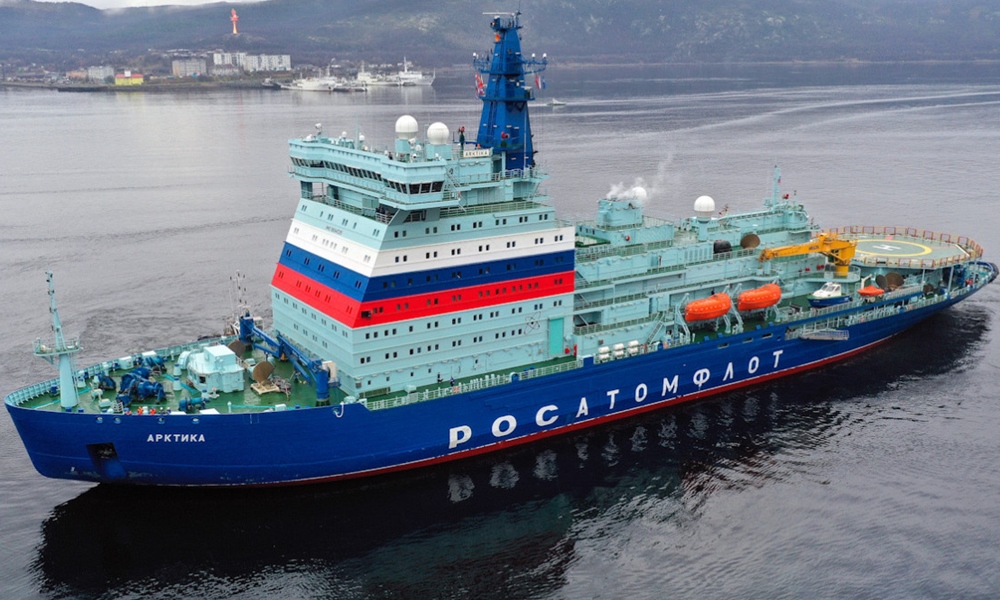
Negotiations between the Russian companies Atomflot and USC (United Shipbuilding Corporation) have been lengthy. In early 2013, the federal government allocated RUB (rubles) 86,1 billion (or ~USD 1,3 billion) for the project. Rosatom (also state-owned corporation) insisted that the two ice-breaking ships should have a total building cost of RUB 77,5 billion (~USD 1,2 billion). However, the offer was declined by the shipbuilder Baltic Shipyard (aka Baltiisky Yard). A second tender with an adjusted shipbuilding price of RUB 84,4 billion was announced in Dec 2013.
Due to the vessel's dual-draft (8,7 m / 10,5 m), Arktika icebreaker's itinerary program is based on Northern Sea Route shipping assistance and includes Arctic Russia sea navigation as well as polar river services. The ship's operational regions in the Arctic Ocean include Barents Sea, Kara Seas, Pechora River, Yenisei River estuary, Ob River (Gulf of Ob).
Russia's nuclear fleet of ice-breaking vessels is used exclusively in the Arctic Ocean for escorting merchant ships and assisting research stations floating in the ice-covered waters north of Siberia. These ships are also used for scientific and Arctic cruise expeditions. The Russian nuclear ice-breakers must sail in ice-cold waters to effectively cool their reactors.
NS Arktika vessel details
Project 22220 class Russian nuclear ships have minimal draught 8,6 m (28 ft) and max draught 10,5 m (34 ft). The dual-draft design makes these vessels capable of operating in both the Arctic Ocean and in ice-covered rivers.
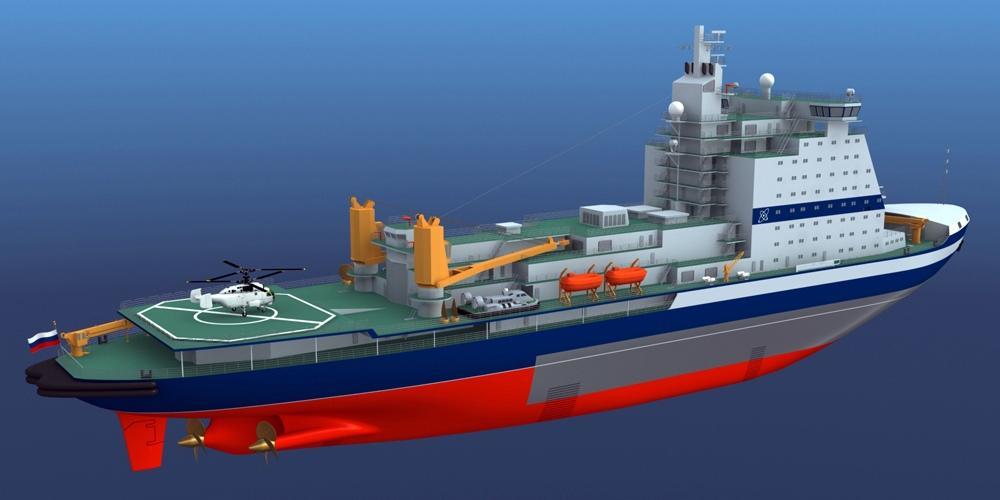
Project 22220 icebreakers are equipped with two RITM-200 nuclear reactors with a total of 350 MW thermal capacity. The propulsion power output is 110 MW. The previous design was for 60 MW output (the reason why this class is alternatively known as "LK-60"). RITM-200 model is a pressurized water reactor developed by OKBM Afrikantov (Russian mechanical engineering company) and designed to produce power output 55 MWe (megawatt electrical). RITM-200 uses up to 20% enriched uranium-235. The reactor is refueled every 7 years and has planned lifespan 40 years. RITM-200 is also used to power Russia's newest and most powerful aircraft carriers (Project 23000E).
Arktika ship's maximum ice-breaking capability is 2,8 m (9 ft) at cruising speed between 1,5-2 knots (2,8 kph / 1,7 mph).
In May 2015 was reported that Russia made a decision on the development of the design for its newest nuclear-powered icebreakers to be able to move across Arctic ice of thickness up to 4.5 m / 15 ft. The icebreaker features propulsion power of 110 MW. Russia's new icebreakers are nearly twice as powerful as Project 22220 nuclear ships.
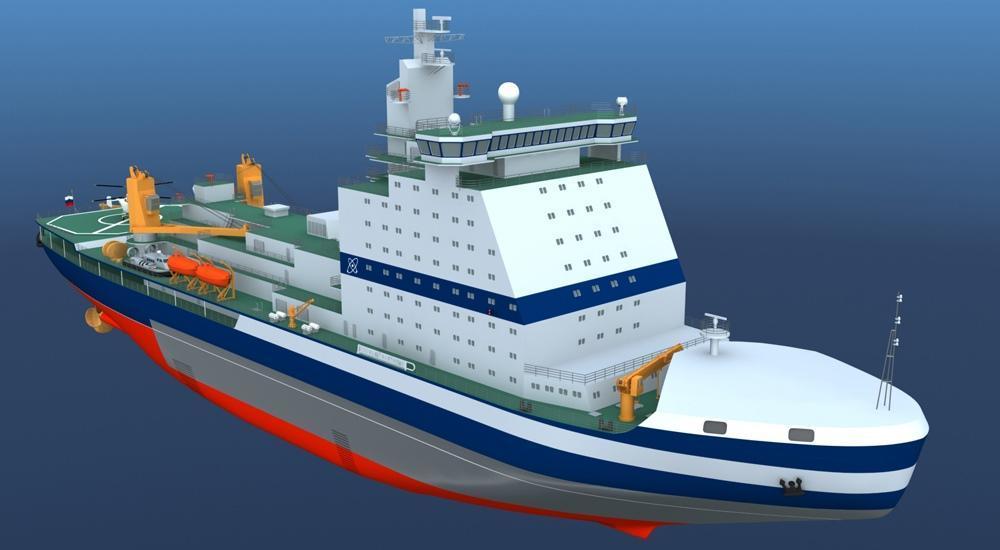
The steel for the Arktika ship (thick plate "Mill 5000") was supplied by the MMK company (Magnitogorsk Iron and Steel Works). The company is one of the world's largest producers and supplies with steel over 50% of Russia's shipbuilding. Steel plate "Mill 5000" is used for manufacturing Russia's naval fleet, as well as for building tankers and ice-class vessels. The steel is certified internationally, including by Lloyd's Register and Bureau Veritas.
The photo below is of the old NS Arktika ship.
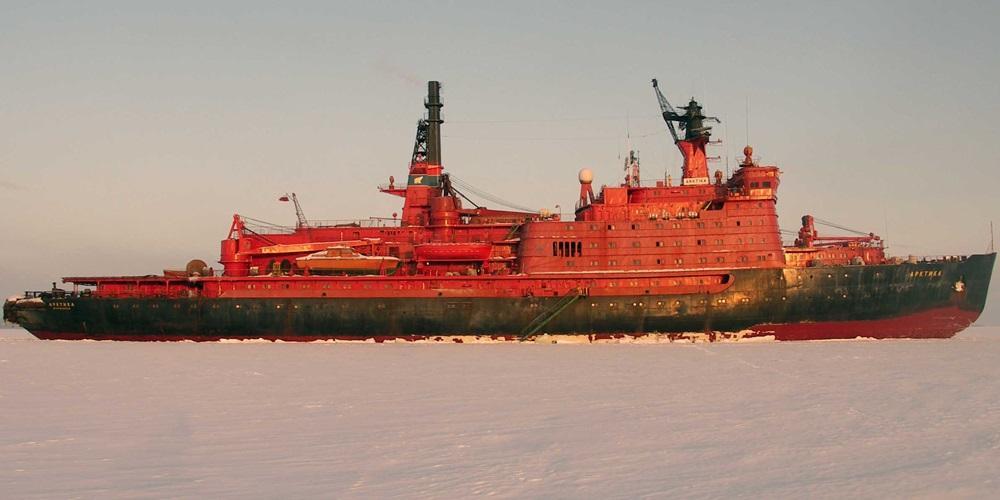
The Arktika ship's namesake was decommissioned in 2008. Built in 1975, the old NS Arktika (IMO 7429061) belonged to the Arktika-class nuclear ships - the world's largest and most powerful ever built. The ship was state-owned but operated by MSCO (Murmansk Shipping Company, later transferred to Atomflot). The old Arktika icebreaker was one of all 10 Russian nuclear ships. It was also among the 6 vessels of this class - together with the old Sibir (1977-1992), Rossiya (1982), Sovetskiy Soyuz (1990), Yamal (1992) and 50 Let Pobedy (2007).
NS Arktika vessel has 1 dining room, Sauna, Library, Auditorium, Passenger Lounge, Volleyball Court, Gymnasium, 1 swimming pool (indoor, heated), Infirmary, 1 elevator, 1 helipad (helicopter deck) with a Mi-2 transport helicopter.
- DWT Deadweight tonnage: 9000 tons
- Displacement tonnage: 33540 tons
- Clear path width: 50 m (164 ft)
- Draught: 8,6 m (28 ft min), 10,5 m (35 ft max)
- Height: 52 m (171 ft)
- Icebreaking capacity: 2,8 m (9 ft)
- Ice-class 9 (highest)
- Lifespan: 40 years (designated service life)
- Range: unlimited
- Powerplant: 2x RITM-200 nuclear reactors (175 MW each/total power output 350 MW)
- Propulsion: 3 shafts (combined power output 110 MW)
Russia's Project 22220 ships have an endurance of 6 months (provisions) and 7 years (nuclear reactor fuel).
Note: In the case of poor AIS coverage, tracking the vessel's current location will be impossible.
You can see CruiseMapper's list of all icebreakers and ice-breaking research ships in the "itinerary" section of our Icebreakers hub. All states and their fleets are listed there.
Other Rosatom-Rosmorport Russia cruise ships
NS Arktika icebreaker Wiki
The vessel's construction officially started with the keel-laying ceremony held on November 5, 2013, at Baltic Shipyard in Sankt-Petersburg Russia.
On June 16, 2016, the world's largest icebreaking vessel was launched (floated out from drydock). The ship's first nuclear reactor (RITM-200 steam generator/power plant) was delivered and installed on September 2, 2016. On November 22 was installed the second nuclear reactor. Each RITM-200 reactor has thermal capacity of 175 MW (350 MV combined power output).
In August 2019 was signed the shipbuilding contract for two more "Project 22220" units (Yakutia and Chukotka/ to 5x icebreakers total). Based on the contract, the shipbuilding cost per unit is RUB 50 billion (~USD 720 million / ~EUR 640 million). NS Arktika icebreaker was officially delivered/commissioned to FSUE Atomflot in Murmansk on October 21, 2020.
On September 5, 2021, Rosatom's Deputy Director (Maxim Kulinko) stated that the Northern Sea Route's year-round service requires two additional Project 22220 ships (6th and 7th). In April 2022 was announced that the Russian Federation plans to allocate from the federal budget RUB 118 billion (~USD 1,7B / EUR 1,6B) for the two icebreakers (cost per unit RUB 59B / USD 851M / EUR 807M), with scheduled deliveries in 2028 (Leningrad) and 2030 (Stalingrad).
In the summer of 1977 (August 9-22) was the Russian (Soviet Union) North Pole expedition on the old Arktika icebreaker leaving roundtrip from Murmansk. The ship was commanded by Captain Yury Kuchiyev and reached the North Pole on August 17. An anniversary voyage in 2017 repeated the 1977 expedition's route with the 50 Let Pobedy nuclear ship. The itinerary started on August 13, 2017, and reached the North Pole on August 17.
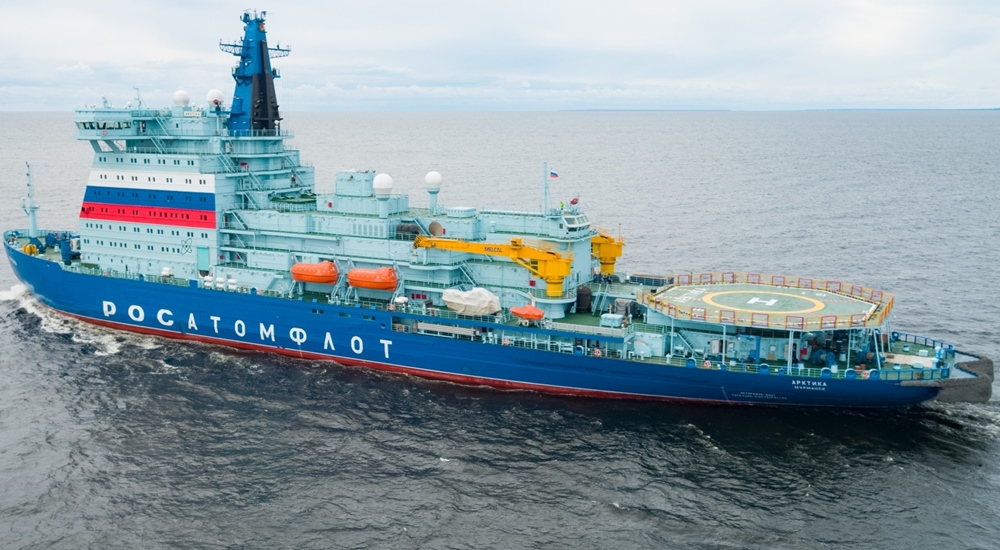
As Project 22220 vessels can navigate both deep (sea) and shallow waters (river estuaries), ROSATOM received two types of ice-breaking ships for the price of one, which means saving hundreds of millions of USD.
NS Arktika and its sisterships are of utmost importance for Russia's strategy to open the Northern Sea Route (NSR) for commercial and military operations the whole year round. By 2030, the NSR will serve vessels carrying 150+ million tonnes of shipments. The Russian Government gave ROSATOM the lead in the route's 6-year infrastructure development project, with total funding RUB 734,9 billion (USD 11,37 billion / EUR 10,17). Of those, RUB 274 billion were provided by the Government, while the remaining RUB 460+ billion were provided by investors, the largest among which are ROSATOM, ROSNEFT and NOVATEK.
ROSATOM (2007-founded) is a state-owned nuclear energy corporation headquartered in Moscow. It comprises over 360 companies and organizations, specializing in scientific research and nuclear weapons, as well as the world's only fleet of nuclear icebreakers. In 2017, ROSATOM produced 202,868 billion kWh of electricity annually or 18,9% of Russia's total electricity. Corporation's construction projects include 33 nuclear powerplant units installed and maintained in 12 countries. It also manufactures related equipment, produces isotopes for nuclear medicine, conducts research and studies, produces supercomputers and software, develops renewable energy technologies (including wind turbines). ROSATOM covers 17,7% of the world's nuclear fuel market and ~35% market share of the global Uranium enrichment services.
ROSNEFT (1993-founded) is a state-controlled gas and oil corporation headquartered in Moscow. The company specializes in research, extraction, production, refinement and transportation of natural gas and petroleum. ROSNEFT is ranked Russia's 3rd largest company and the country's 2nd-largest state-controlled (after Gazprom) and the world's 24th largest oil company in terms of revenue (FY2017 - USD 103 billion / EUR 92,09 billion).
NOVATEK (1994-founded) is Russia's 2nd-largest natural gas producer and the world's 7th-largest stock-listed company by annual natural gas production volume. The company is listed and traded on London (LSE) and Moscow (MCX) stock exchanges. Major shareholders are Leonid Michelson (CEO, ~28%), Volga Group (23%), Total SA (French multinational, ~16%) and Gazprom (9,4%).


